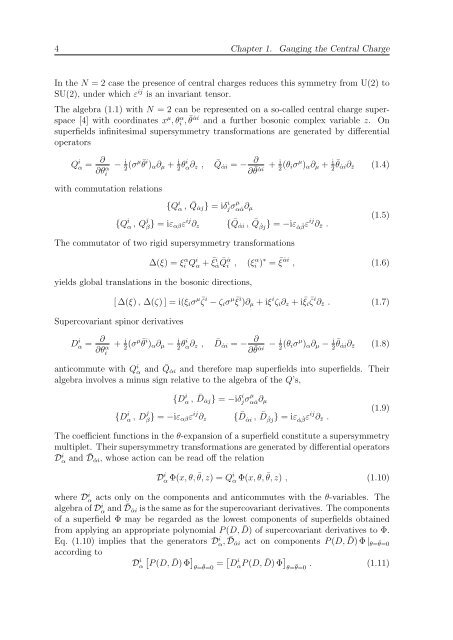N=2 Supersymmetric Gauge Theories with Nonpolynomial Interactions
N=2 Supersymmetric Gauge Theories with Nonpolynomial Interactions
N=2 Supersymmetric Gauge Theories with Nonpolynomial Interactions
You also want an ePaper? Increase the reach of your titles
YUMPU automatically turns print PDFs into web optimized ePapers that Google loves.
4 Chapter 1. Gauging the Central Charge<br />
In the N = 2 case the presence of central charges reduces this symmetry from U(2) to<br />
SU(2), under which ε ij is an invariant tensor.<br />
The algebra (1.1) <strong>with</strong> N = 2 can be represented on a so-called central charge superspace<br />
[4] <strong>with</strong> coordinates x µ , θ α i , ¯ θ ˙αi and a further bosonic complex variable z. On<br />
superfields infinitesimal supersymmetry transformations are generated by differential<br />
operators<br />
Q i α = ∂<br />
∂θ α i<br />
− i<br />
2 (σµ¯ θ i )α∂µ + i<br />
<strong>with</strong> commutation relations<br />
{Q i α , Q j<br />
β } = iεαβε ij ∂z<br />
2θi α∂z , Q¯ ˙αi = − ∂<br />
∂ ¯ θ<br />
{Q i α , ¯ Q ˙αj} = iδ i jσ µ<br />
α ˙α ∂µ<br />
˙αi + i<br />
2 (θiσ µ )α∂µ + i<br />
2 ¯ θ ˙αi∂¯z<br />
{ ¯ Q ˙αi , ¯ Q ˙ βj } = −iε ˙α ˙ β ε ij ∂¯z .<br />
The commutator of two rigid supersymmetry transformations<br />
(1.4)<br />
(1.5)<br />
∆(ξ) = ξ α i Q i α + ¯ ξ i ˙α ¯ Q ˙α i , (ξ α i ) ∗ = ¯ ξ ˙αi , (1.6)<br />
yields global translations in the bosonic directions,<br />
[ ∆(ξ) , ∆(ζ) ] = i(ξiσ µ ¯ ζ i − ζiσ µ ¯ ξ i )∂µ + iξ i ζi∂z + i ¯ ξi ¯ ζ i ∂¯z . (1.7)<br />
Supercovariant spinor derivatives<br />
D i α = ∂<br />
∂θ α i<br />
+ i<br />
2 (σµ¯ θ i )α∂µ − i<br />
2θi α∂z , D¯ ˙αi = − ∂<br />
∂ ¯ i −<br />
θ ˙αi 2 (θiσ µ )α∂µ − i<br />
2 ¯ θ ˙αi∂¯z<br />
(1.8)<br />
anticommute <strong>with</strong> Q i α and ¯ Q ˙αi and therefore map superfields into superfields. Their<br />
algebra involves a minus sign relative to the algebra of the Q’s,<br />
{D i α , D j<br />
β } = −iεαβε ij ∂z<br />
{D i α , ¯ D ˙αj} = −iδ i jσ µ<br />
α ˙α ∂µ<br />
{ ¯ D ˙αi , ¯ D ˙ βj } = iε ˙α ˙ β ε ij ∂¯z .<br />
(1.9)<br />
The coefficient functions in the θ-expansion of a superfield constitute a supersymmetry<br />
multiplet. Their supersymmetry transformations are generated by differential operators<br />
D i α and ¯ D ˙αi, whose action can be read off the relation<br />
D i α Φ(x, θ, ¯ θ, z) = Q i α Φ(x, θ, ¯ θ, z) , (1.10)<br />
where Di α acts only on the components and anticommutes <strong>with</strong> the θ-variables. The<br />
algebra of Di α and ¯ D ˙αi is the same as for the supercovariant derivatives. The components<br />
of a superfield Φ may be regarded as the lowest components of superfields obtained<br />
from applying an appropriate polynomial P (D, ¯ D) of supercovariant derivatives to Φ.<br />
Eq. (1.10) implies that the generators Di α, ¯ D ˙αi act on components P (D, ¯ D) Φ | θ= θ=0 ¯<br />
according to<br />
D i <br />
α P (D, D) ¯ Φ θ= ¯ θ=0 = D i αP (D, ¯ D) Φ <br />
θ= ¯ . (1.11)<br />
θ=0

















